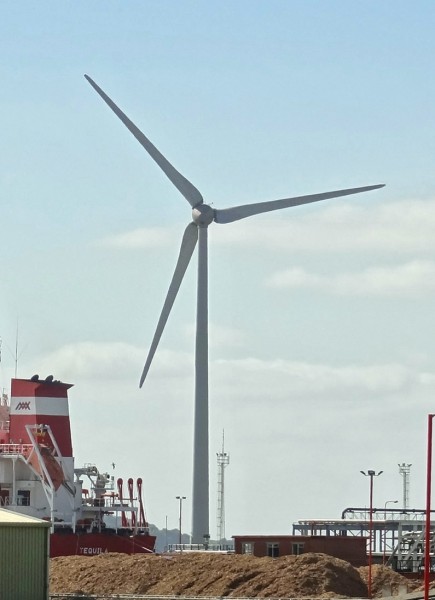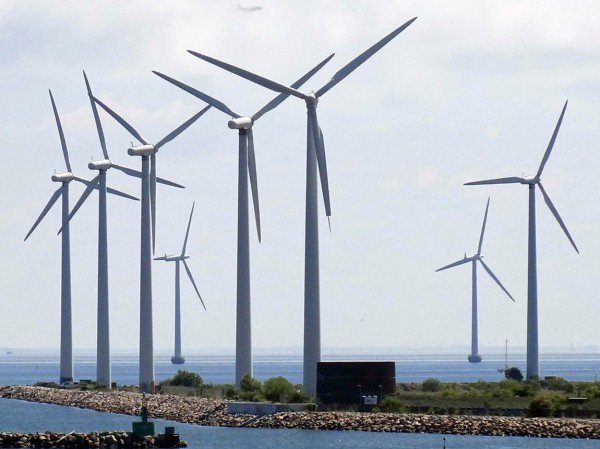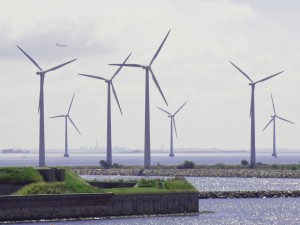 When an industry produces positive externalities, there is an argument for granting subsidies. To achieve the socially efficient output in an otherwise competitive market, the marginal subsidy should be equal to the marginal externality. This is the main argument for subsidising wind power. It helps in the switch to renewable energy away from fossil fuels. There is also the secondary argument that subsidies help encourage the development of technologies that would be too uncertain to fund at market rates.
When an industry produces positive externalities, there is an argument for granting subsidies. To achieve the socially efficient output in an otherwise competitive market, the marginal subsidy should be equal to the marginal externality. This is the main argument for subsidising wind power. It helps in the switch to renewable energy away from fossil fuels. There is also the secondary argument that subsidies help encourage the development of technologies that would be too uncertain to fund at market rates.
If subsidies are to be granted, it is important that they are carefully designed. Not only does their rate need to reflect the size of the positive externalities, but also they should not entail any perverse incentive effects. But this is the claim about subsidies given to wind turbines: that they create an undesirable side effect.
Small-scale operators are encouraged to build small turbines by offering them a higher subsidy per kilowatt generated (through higher ‘feed-in’ tariffs). But according to a report by the Institute for Public Policy Research (IPPR), this is encouraging builders and operators of large turbines to ‘derate’ them. This involves operating them below capacity in order to get the higher tariff. As the IPPR overview states:
The scheme is designed to support small-scale providers, but the practice of under-reporting or ‘derating’ turbines’ generating capacity to earn a higher subsidy is costing the taxpayer dearly and undermining the competitiveness of Britain’s clean energy sector.
The loophole sees developers installing ‘derated’ turbines – that is, turbines which are ‘capped’ so that they generate less energy. Turbines are derated in this way so that developers and investors are able to qualify for the more generous subsidy offered to lower-capacity turbines, generating 100–500kW.  By installing derated turbines, developers are making larger profits off a feature of the scheme that was designed to support small-scale projects. Currently, the rating of a turbine is declared by the manufacturer and installer, resulting in a lack of external scrutiny of the system.
By installing derated turbines, developers are making larger profits off a feature of the scheme that was designed to support small-scale projects. Currently, the rating of a turbine is declared by the manufacturer and installer, resulting in a lack of external scrutiny of the system.
The subsidies are funded by consumers through higher electricity prices. As much as £400 million could be paid in excess subsidies. The lack of scrutiny means that operators could be receiving as much as £100 000 per year per turbine in excess subsidies.
However, as the articles below make clear, the facts are disputed by the wind industry body, RenewableUK. Nevertheless, the report is likely to stimulate debate and hopefully a closing of the loophole.
Video
 Turbine power: the cost of wind power to taxpayers Channel 4 News, Tom Clarke (10/2/15)
Turbine power: the cost of wind power to taxpayers Channel 4 News, Tom Clarke (10/2/15)
Articles
Wind subsidy loophole boosts spread of bigger turbines Financial Times, Pilita Clark (10/2/15)
Call to Close Wind Power ‘Loophole’ Herald Scotland, Emily Beament (10/2/15)
Wind farm developers hit back at ‘excessive subsidy’ claims Business Green, Will Nichols (10/2/15)
The £400million feed-in frenzy: Green energy firms accused of making wind turbines LESS efficient so they appear weak enough to win small business fund Mail Online, Ben Spencer (10/2/15)
Wind power subsidy ‘loophole’ identified by new report Engineering Technology Magazine, Jonathan Wilson (11/2/15)
Report
Feed-in Frenzy Institute for Public Policy Research, Joss Garman and Charles Ogilvie (February 2015)
Questions
- Draw a diagram to demonstrate the optimum marginal rate of a subsidy and the effect of the subsidy on output.
- Who should pay for subsidies: consumers, the government (i.e. taxpayers generally), electricity companies through taxes on profits made from electricity generation using fossil fuels, some other source? Explain your thinking.
- What is the argument for giving a higher subsidy to operators of small wind turbines?
- If wind power is to be subsidised, is it better to subsidise each unit of output of electricity, or the construction of wind turbines or both? Explain.
- What could Ofgem do (or the government require Ofgem to do) to improve the regulation of the wind turbine industry?
 The UK hosted the third Clean Energy Ministerial conference on 25/26 April 2012. More than 20 energy ministers from around the world attended. In his address, David Cameron, gave his backing to more wind farms being built in the UK, both onshore and offshore.
The UK hosted the third Clean Energy Ministerial conference on 25/26 April 2012. More than 20 energy ministers from around the world attended. In his address, David Cameron, gave his backing to more wind farms being built in the UK, both onshore and offshore.
Currently just under 10 per cent of the UK’s electricity is generated from renewable sources. But to meet agreed EU targets this must increse to at least one-third by 2020. Most of this will have to come from wind.
But whilst wind turbines create no CO2 emissions, electricity generated from wind is currently some 15% more expensive than from gas. To make wind power profitable, energy companies are required by law to generate a certain percentage of their electricity from renewables and the cost is passed on to the consumer. This adds some £20 per year to the average household energy bill.
Over the coming years, many new power plants will have to be built to replace the electricity generated from older plants that reach the end of their life. So what types of plant should be built? Unfortunately measuring the costs and benefits from power generation is not easy. For a start, energy needs are not easy to predict. But more importantly, electricity generation involves huge environmental and social externalities. And these are extremely difficult to measure.
What is more, the topic is highly charged politically. The social costs do not fall evenly on the population. People might favour wind turbines, but they do not want to see one outside their window – or from their golf course!
The following videos and articles will give you some insight into the difficulties that any decision makers face in making the ‘right’ decisions about electricity generation
Webcasts and podcasts
 Can Cameron still claim the ‘greenest government ever’? Channel 4 News, Tom Clarke (26/4/12)
Can Cameron still claim the ‘greenest government ever’? Channel 4 News, Tom Clarke (26/4/12)
 Energy Secretary: UK will meet green targets BBC News, Ed Davey (25/4/12)
Energy Secretary: UK will meet green targets BBC News, Ed Davey (25/4/12)
 Donald Trump attacks Scottish government’s green policy BBC News, James Cook (25/4/12)
Donald Trump attacks Scottish government’s green policy BBC News, James Cook (25/4/12)
 Trump: Wind farms ‘bad for Scotland’ BBC News (24/4/12)
Trump: Wind farms ‘bad for Scotland’ BBC News (24/4/12)
 Tycoon Trump fights Scotland over wind farms near golf resortReuters, Deborah Gembara (25/4/12)
Tycoon Trump fights Scotland over wind farms near golf resortReuters, Deborah Gembara (25/4/12)
 Wind power blows Siemens off course Euronews, Anne Glemarec (25/4/12)
Wind power blows Siemens off course Euronews, Anne Glemarec (25/4/12)
 Mexico inaugurates largest wind farm in Latin America BBC News, Carolina Robino (9/3/12)
Mexico inaugurates largest wind farm in Latin America BBC News, Carolina Robino (9/3/12)
 BP’s Flat Ridge 2 Wind Farm in Kansas YouTube, BPplc (10/4/12)
BP’s Flat Ridge 2 Wind Farm in Kansas YouTube, BPplc (10/4/12)
 Arnold Schwarzenegger: Green quest goes on BBC News (26/4/12)
Arnold Schwarzenegger: Green quest goes on BBC News (26/4/12)
 Denmark Pioneers Clean Energy Green TV (18/4/12)
Denmark Pioneers Clean Energy Green TV (18/4/12)
 EU wind industry defies recession Green TV (16/4/12)
EU wind industry defies recession Green TV (16/4/12)
 Wind Farm Issues – Compilation LiveLeak (15/4/12)
Wind Farm Issues – Compilation LiveLeak (15/4/12)
News articles
David Cameron commits to wind farms The Telegraph, Louise Gray (26/4/12)
David Cameron says wind energy must get cheaper The Telegraph, Louise Gray (27/4/12)
Could 2012 be year of the wind turbine? The Telegraph, Louise Gray (3/2/12)
Green energy vital, says David Cameron Independent, Emily Beament (26/4/12)
Cameron: renewables are ‘vital to our future’ businessGreen, Will Nichols and James Murray (26/4/12)
Green energy ‘must be affordable’ – Cameron BBC News (26/4/12)
Wind farms will kill tourism, says Donald Trump Independent (25/4/12)
Donald Trump accuses Salmond of ‘betrayal’ over wind farm plans The Telegraph, Simon Johnson (25/4/12)
Turbine scheme provokes wuthering gale of protest Independent, Mark Branagan (6/4/12)
Prince Charles endorses wind power in new film at Sundance Festival The Telegraph, Roya Nikkhah (29/4/12)
Study claims tourists ‘not put off’ by wind farms in Scotland BBC News (24/4/12)
Tide turns in favour of wave power instead of wind farms Scotsman, David Maddox (23/4/12)
Rush towards wind-generated electricity will not reduce fuel poverty Power Engineering (21/4/12)
Shell says no to North Sea wind power Guardian, Terry Macalister (26/4/12)
David Cameron, the Speech He Needs to Make Huffington Post, Juliet Davenport (25/4/12)
Campaigners want David Cameron to come clean over wind farm policy Western Daily Press (27/4/12)
Being Green Doesn’t Mean Higher Electricity Costs Says Green Energy UK DWPub (27/4/12)
Documents
Cost Benefit Methodology for Optimal Design of Offshore Transmission Systems Centre for Sustainable Electricity and Distributed Generation, Predrag Djapic and Goran Strbac (July 2008)
A Cost Benefit Analysis of Wind Power University College Dublin, Eleanor Denny (19/1/07)
Ecological and economic cost-benefit analysis of offshore wind energy Renewable Energy 34, Brian Snyder, Mark J. Kaiser (2009)
Questions
- Why is difficult to predict the future (financial) cost per kilowatt-hour of electricity generation by the various methods?
- Why is it difficult to estimate the demand for electricity in 10 years’ time?
- Identify the external benefits and costs of electricity generation from (a) onshore wind turbines; (b) offshore wind turbines.
- Is ‘willingness to pay’ a good method of establishing the value of external benefits and costs?
- What are the steps in a cost–benefit analysis?
- What types of problems are there in measuring external benefits and costs?
 When an industry produces positive externalities, there is an argument for granting subsidies. To achieve the socially efficient output in an otherwise competitive market, the marginal subsidy should be equal to the marginal externality. This is the main argument for subsidising wind power. It helps in the switch to renewable energy away from fossil fuels. There is also the secondary argument that subsidies help encourage the development of technologies that would be too uncertain to fund at market rates.
When an industry produces positive externalities, there is an argument for granting subsidies. To achieve the socially efficient output in an otherwise competitive market, the marginal subsidy should be equal to the marginal externality. This is the main argument for subsidising wind power. It helps in the switch to renewable energy away from fossil fuels. There is also the secondary argument that subsidies help encourage the development of technologies that would be too uncertain to fund at market rates.By installing derated turbines, developers are making larger profits off a feature of the scheme that was designed to support small-scale projects. Currently, the rating of a turbine is declared by the manufacturer and installer, resulting in a lack of external scrutiny of the system.
 Turbine power: the cost of wind power to taxpayers Channel 4 News, Tom Clarke (10/2/15)
Turbine power: the cost of wind power to taxpayers Channel 4 News, Tom Clarke (10/2/15)